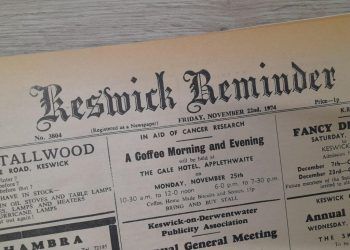
A pop-up car park at the base of Catbells has reignited the row over whether a permanent one should be created at nearby Ullock Moss.
Under the Government’s 56-day rule, that allows landowners to open pop-up sites within the Lake District National Park, a free temporary car
park has already been opened in a field in Portinscale.
It has been opened by Mike Anderton whose plans to create a permanent space for 150 vehicles, as well as toilets and a bike hire shop, has seen developers, residents and campaigners at loggerheads. It is understood drivers would pay £5 a day to park there.
The team behind the proposal say the pop-up car park, opened last month, has already succeeded in freeing up congested roads and lanes of parked cars, and that a permanent site will further improve traffic flow through the village.
But while plans have been submitted to the Lake District National Park Authority (LDNPA) for consideration, Portinscale residents themselves are increasingly divided over the proposed development.
And those opposing the scheme, who include include the National Trust, Natural England and environmental groups such as Friends of the Lake District, blame the LDNPA for failing to create sustainable travel hubs and potentially turning rural villages into free-for-all visitor car parks.
The car park would be on land owned by the Lingholm Private Trust.
Owner and director Mr Anderton said: “The current situation, with visitors parking wherever they like, is unsustainable, and the feedback we’ve had from local people to the introduction of the temporary car park has been hugely positive.
“There have been objections – but we are not some developer who has rocketed up from London. We have been through the process with planners and designers and the car park will be in keeping with the surroundings.
“Despite what some people say, it’s not going to look like Booth’s car park.”
Mr Anderton’s pop-up car park has received the backing of Keswick councillor and LDNPA board member Tony Lywood, who described it as a “godsend”.
“As soon as it opened I could clearly see the reduction of the illegal parking and congestion that has blighted this most beautiful part of the Lakes,” he said.
“If I had my way I would extend the 56 days allowed for these projects to 72, as these are not permanent car parks and do a great job for everyone involved.”
Mr Lywood declined to comment on the planned permanent car park.
According to the LDNPA’s planning website there have so far been 333 responses against the plan compared to 325 in favour.
However, when this is broken down to Portinscale residents only, then the figures are 67 against and just 18 for.
Gareth Cosslett, who has lived in the village since 2019, is one of those who believes the car park is a bad idea.
“We are not NIMBYs, we just think that a permanent car park on that site is going to create far more problems than it solves,” he said.
“It’s basically an open invitation for more people to drive to – and through – Portinscale. And once the car park is full, or drivers see that they’ve got to pay, what then?
“They’re just going to park in the road and there will be even worse gridlock than there is now.”
Mr Cosslett believes the solution is to build a dedicated transport hub on the A66 on the outskirts of Keswick – a view shared by pressure group Friends of the Lake District.
Planning officer Lorayne Wall said: “A permanent car park would be a conflict of the LDNPA’s local plan policies, but it’s also about the huge numbers of cars in the Lake District.
“They should be implementing a more far-reaching and sustainable strategy designed to reduce and control traffic, instead of encouraging more vehicles.”
Ms Wall points to the Snowdonia National Park in Wales as an example of how it should be done.
“There the authorities ask motorists to book parking tickets in advance, they have bus services, and some of the most popular valleys – their equivalent of Wasdale or Borrowdale – are closed to cars entirely,” she said.
According to Friends of the Lake District, visitor growth to the area over the past few years has been significant, rising from 14.8 million visitors in 2012 to around 20 million in 2018.
It is estimated that 83 per cent of visitors travel to the Lake District by car and over half of them use their cars as their main mode of transport within the park.








